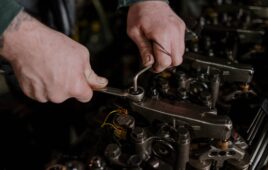Written by Jody Muelaner

Flanges (as shown in red) on a selection of different objects. From left to right: I-beam, T-beam, flange bolt, and pipe flange.
A flange is a protruding ridge or rim, often used to increase strength or spread the load.
For example, sectional beams often have flanges that carry most of the load and that are connected by a web joining the flanges together. Pipes may also be fitted with flanges, which provide attachments. Nuts and bolts may include flanges to spread the clamping force over an increased area.
Pipe flanges
Pipe flanges form a rim that radially protrudes from the end of a pipe. They have several holes that allow two pipe flanges to be bolted together, forming a connection between two pipes. A gasket may be fitted between two flanges to improve the seal.
Pipe flanges are available as discrete parts for use in joining pipes. The pipe flange is attached permanently or semi-permanently to the end of a pipe. It then facilitates easy assembly and disassembly of the pipe to another pipe flange.
Pipe flanges are classified according to how they are attached to the pipe.

A pipe flange.
Types of pipe flange include:
- Weld neck flanges are butt welded onto the end of a pipe, providing a flange that is suitable for high temperature and pressure.
- Threaded flanges have an internal (female) thread, a threaded pipe is screwed into it. This is relatively easy to fit but not suitable for high pressure and temperature.
- Socket-welded flanges have a plain hole with a shoulder at the bottom. The pipe is inserted into the hole to butt against the shoulder and is then welded into place with a fillet weld around the outside. This is used for small diameter pipes operating at low pressure.
- Slip-on flanges also have a plain hole but without the shoulder. Fillet welds are applied to the pipe on both sides of the flange.
- Lapped flanges consist of two parts; a stubend and a backing flange. The subend is butt-welded to the end of the pipe and includes a small flange without any holes. The backing flange can slide over the stubend and provides holes to bolt to another flange. This arrangement allows disassembly in confined spaces.
- Blind flanges are a form of blanking plate that is bolted to another pipe flange to isolate a section of piping or terminate piping.





exellent job!!